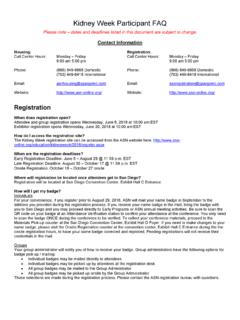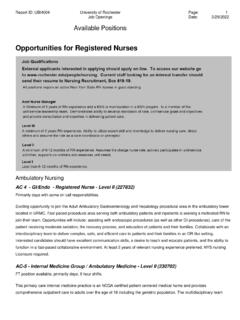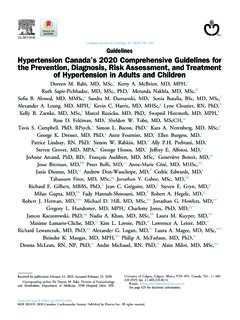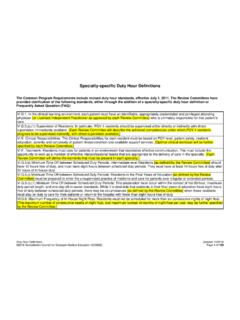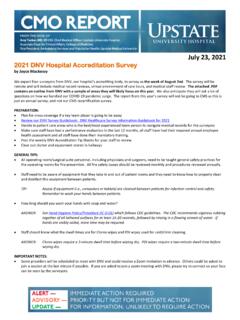Transcription of Chronic Kidney Disease (CKD) - American Society of …
1 DIVISIONS OF nephrology & HYPERTENSIONAND GENERAL INTERNAL MEDICINEC hronic Kidney Disease (CKD) Clinical Practice Recommendationsfor Primary Care Physiciansand Healthcare ProvidersA Collaborative Approach(Edition )Delicate durability describes the human body, and nowhere is this more apparent than in the urinary tract. If the liver is all bulk and thunder, the heart fist and thrust and piston, and the brain a foamy paste of insubstantial electricity, the parts of the urinary tract namely the kidneys, ureters, and bladder are a tracery of tubules and ducts of such a fineness as would lay mad a master plumber, more, a Venetian glassblower. RICHARD SELZER (1996) DISCLAIMER. Final treatment recommendations are the responsibility of the prescribing healthcare provider and are in no manner considered the responsibility of Henry Ford Health System, its agents, providers, or the authors. COPYRIGHT 2002, 2003, 2004, 2006, 2007, AND 2011. HENRY FORD HEALTH SYSTEM.
2 All rights reserved. No part of this publication may be reproduced, transmitted, transcribed, stored in a retrieval system, or translated into any language in any form or by any means without written permission of Henry Ford Health System. Delicate durability describes the human body, and nowhere is this more apparent than in the urinary tract. If the liver is all bulk and thunder, the heart fist and thrust and piston, and the brain a foamy paste of insubstantial electricity, the parts of the urinary tract namely the kidneys, ureters, and bladder are a tracery of tubules and ducts of such a fineness as would lay mad a master plumber, more, a Venetian glassblower. RICHARD SELZER (1996) DISCLAIMER. Final treatment recommendations are the responsibility of the prescribing healthcare provider and are in no manner considered the responsibility of Henry Ford Health System, its agents, providers, or the authors. COPYRIGHT 2002, 2003, 2004, 2006, 2007, AND 2011.
3 HENRY FORD HEALTH SYSTEM. All rights reserved. No part of this publication may be reproduced, transmitted, transcribed, stored in a retrieval system, or translated into any language in any form or by any means without written permission of Henry Ford Health System. Delicate durability describes the human body, and nowhere is this more apparent than in the urinary tract. If the liver is all bulk and thunder, the heart fist and thrust and piston, and the brain a foamy paste of insubstantial electricity, the parts of the urinary tract namely the kidneys, ureters, and bladder are a tracery of tubules and ducts of such a fineness as would lay mad a master plumber, more, a Venetian glassblower. RICHARD SELZER (1996) DISCLAIMER. Final treatment recommendations are the responsibility of the prescribing healthcare provider and are in no manner considered the responsibility of Henry Ford Health System, its agents, providers, or the authors. COPYRIGHT 2002, 2003, 2004, 2006, 2007, AND 2011.
4 HENRY FORD HEALTH SYSTEM. All rights reserved. No part of this publication may be reproduced, transmitted, transcribed, stored in a retrieval system, or translated into any language in any form or by any means without written permission of Henry Ford Health System. Delicate durability describes the human body, and nowhere is this more apparent than in the urinary tract. If the liver is all bulk and thunder, the heart fist and thrust and piston, and the brain a foamy paste of insubstantial electricity, the parts of the urinary tract namely the kidneys, ureters, and bladder are a tracery of tubules and ducts of such a fineness as would lay mad a master plumber, more, a Venetian glassblower. RICHARD SELZER (1996) DISCLAIMER. Final treatment recommendations are the responsibility of the prescribing healthcare provider and are in no manner considered the responsibility of Henry Ford Health System, its agents, providers, or the authors. COPYRIGHT 2002, 2003, 2004, 2006, 2007, AND 2011.
5 HENRY FORD HEALTH SYSTEM. All rights reserved. No part of this publication may be reproduced, transmitted, transcribed, stored in a retrieval system, or translated into any language in any form or by any means without written permission of Henry Ford Health System. CONTENTS FOREWORD 2 Chronic Kidney Disease STAGING AND PROGRESSION 4 CONSULTATION 11 DIABETIC Kidney Disease 15 HYPERTENSION IN Chronic Kidney Disease 19 PROTEINURIA IN Chronic Kidney Disease 24 ANEMIA OF Chronic Kidney Disease 28 CKD-MINERAL AND BONE DISORDER 31 DYSLIPIDEMIA OF Chronic Kidney Disease 40 NUTRITION IN Chronic Kidney Disease 43 IMMUNIZATIONS IN Chronic Kidney Disease 45 Kidney REPLACEMENT THERAPY 48 MEDICATION-RELATED PROBLEMS 51 SELECTED AGENTS 56 DIAGNOSTIC CODING PRINCIPLES 63 Chronic Kidney Disease DIAGNOSTIC CODES 66 CKD WEBSITES OF INTEREST 69 COMMENTS TO AUTHORS 69 WEBSITE MANAGEMENT 70 PURCHASING INFORMATION 70 Chronic Kidney Disease CHECKLIST 71 PLAN OF CARE & ACTION PLAN 36 DIAGRAMS Consultation 14 Approach to Hypertension Treatment in CKD 23 CKD Proteinuria Evaluation 27 Management of Mineral-Bone Disease in CKD 39 CKD Dyslipidemia Treatment 42 2 Foreword IDNEY Disease .
6 Some acute but mostly Chronic remains the core of this SIXTH EDITION of Chronic Kidney Disease (CKD): CLINICAL PRACTICE RECOMMENDATIONS FOR PRIMARY CARE PHYSICIANS AND HEALTHCARE PROVIDERS A COLLABORATIVE APPROACH by Editors Jerry Yee & Gregory D. Krol. This edition represents a significant departure from Editions 1 5. It is now multi-authored, underscoring the complexity of Chronic Kidney Disease , better known in the vernacular as CKD a Disease domain complex that is highly associated with a progressive cardiovascular Disease burden. Aside from the multi-authorship of the SIXTH EDITION, this work provides exciting illustrations by Dunham Design and immaculate print quality by Dynamic Marketing. As with prior editions, the writing remains consistently concise, precise, and decisive. NTERESTINGLY, the booklet was originally conceived and written for the Henry Ford Health System. However, like the automotive industry of the City of Detroit, it has significantly transcended its local borders.
7 All told, more than 30,000 copies have been distributed within the United States, Puerto Rico, Mexico, and Canada since its original publication. From the first edition that provided textually based "nuts and bolts" management of CKD through its fifth edition, the booklet has gained in quality and size, while providing up-to-date information. The first edition brought to the fore the importance of the eGFR in the screening of this under-recognized entity, CKD. The second and third editions amplified the importance of the cardiovascular complications of CKD. The fourth and fifth editions emphasized evidence-based practice across the continuum of CKD care and provided colorful easy-to-read diagrams. Essentially, it is not a textbook steeped in information that is outdated by the time of printing, but a periodical that reliably informs Primary Care Physicians about CKD essentials. Overall, the content is current and crystallized, ready for translation into clinical practice.
8 EDICATED readings of the HENRY FORD CKD BOOKLET as it is known outside of the Henry Ford Health System are suggested in order to fully comprehend the complexity of CKD. It should be on the "must have" list of Internal Medicine housestaff and nephrology fellows-in-training as it continues to remain popular among the younger generation of physicians, nurses, and mid-level providers. Its Internet presence accounted for 1,000 downloads in 2010. Translation into other languages is under consideration and there is clamor for mobile device distribution. Most importantly, the booklet has received plaudits from national organizations and societies, and its format and content have been adapted by multiple agencies, including the Michigan Quality Initiative Consortium (MQIC) and the National Kidney Foundations of Michigan and Illinois. K I D 3 EW information regarding the eGFR is highlighted in the SIXTH EDITION. As the underpinning of the stages of CKD, knowledge regarding the functionality of the eGFR has matured, with validation across more populations.
9 Standardization of the serum creatinine by isotope dilution mass spectrometry is occurring increasingly across clinical laboratories in the United States. This recalibration lowers the eGFR by 6%. Notwithstanding this improvement in eGFR reporting, combining this parameter with proteinuria more clearly delineates the risk category of a CKD patient. Principally, proteinuria of 2+ on dipstick analysis or within the macro-albuminuric range portends a poorer renal outcome. Lastly, this edition prominently features an international perspective on CKD-Mineral and Bone Disorder. XPERT and representation of the respective clinical Disease domains of CKD distinguishes and enhances this version. Now, this mini-compendium renders an even broader perspective to CKD with the following contributions: DIABETIC Kidney Disease by Susanne Nicholas (UCLA) HYPERTENSION by Debbie Cohen and Raymond Townsend (Univ. of Penn) PROTEINURIA by Julie Lin (Brigham and Women s Hospital) ANEMIA OF CKD by Anatole Besarab (Henry Ford Hospital) NUTRITION IN CKD by M.
10 Cristina Kilates (Henry Ford Hospital) CKD-MINERAL AND BONE DISORDER by L. Tammy Ho (Univ. of Chicago) MEDICATION-RELATED PROBLEMS & SELECTED AGENTS by Carol Moore (Henry Ford Hospital) Kidney REPLACEMENT THERAPY by Jariatul Karim & Lalathaksha Kumbar (Henry Ford Hospital) WEBSITE MANAGEMENT by Gerard Zasuwa (Henry Ford Hospital) Each chapter follows the outlines of the previous versions: brief introduction, evidence base, pathophysiology, and guideline- or expert consensus-based diagnosis and therapy. THE PLAN OF CARE & ACTION PLAN and the CHECKLIST remain outstandingly simple, informative, and efficient formats to present a large body of information into digestible learnings. These two invaluable components of the SIXTH EDITION distill numerous guidelines and consensus-based recommendations by level of evidence and grade of quality to improve our practices. ES! is the feeling that I had upon completing the SIXTH EDITION. You, the reader should review it, digest it, practice it, and also, enjoy it.


